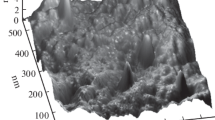Abstract
The formation of InAs1−x−y SbxBiy/InSb and InAs1−x−y SbxBiy/InSbyBiy strained-layer heterostructures by “capillary” LPE is simulated. The laws governing the dependence of the gap width E g and the thickness d of the epilayers on the conditions of the process are revealed. It is shown that because of the sharp increase in the rate of epitaxial deposition as the LPE temperature is raised, the successful growth of epilayers of subcritical thickness is possible only up to T<550 K. The influence of the rate of laminar flow of the liquid in the growth channel in a relaxation regime and in a continuous pumping regime on the uniformity of the distribution of E g and d in the epitaxial heterostructures is analyzed. Effective combinations of parameters for carrying out the process, which ensure the achievement of E g ≈0.1 eV (77 K) in the active layers with variable-band-gap layers of minimal thickness, are established.
Similar content being viewed by others

References
R. Kh. Akchurin and T. V. Sakharova, Pis’ma Zh. Tekh. Fiz. 18(10), 16 (1992) [Sov. Tech. Phys. Lett. 18, 307 (1992)].
R. Kh. Akchurin and O. V. Akimov, Fiz. Tekh. Poluprovodn. 29, 362 (1995) [Semiconductors 29, 183 (1995)].
R. Kh. Akchurin and D. V. Komarov, Zh. Tekh. Fiz. 67(7), 42 (1997) [Tech. Phys. 42, 755 (1997)].
R. Kh. Akchurin, in Physicochemical Processes in Microelectronics [in Russian], MITKhT, Moscow (1990), pp. 318–342.
R. Kh. Akchurin, T. V. Sakharova, and V. A. Zhegalin, Izv. Vyssh. Uchebn. Zaved. Tsvetn. Metall. (7), 23 (1994).
R. Kh. Akchurin, V. A. Zhegalin, and T. V. Sakharova, Izv. Ross. Akad. Nauk Ser. Neorg. Mater. (1995) (in press).
G. T. Aitieva, V. N. Bessolov, S. E. Klimenko et al., Pis’ma Zh. Tekh. Fiz. 11, 465 (1985) [Sov. Tech. Phys. Lett. 11, 192 (1985)].
Yu. Yu. Abdurakhmanov, S. E. Klimenko, and V. E. Korsukov, Pis’ma Zh. Tekh. Fiz. 8, 762 (1982) [Sov. Tech. Phys. Lett. 8, 331 (1982)].
S. S. Strel’chenko and V. V. Lebedev, III-V Compounds (A Handbook) [in Russian], Metallurgiya, Moscow (1984).
Physicochemical Properties of Semiconductor Materials (A Handbook) [in Russian], A. V. Novoselova and V. B. Lazarev (eds.), Nauka, Moscow (1979).
V. B. Ufimtsev and R. Kh. Akchurin, Physicochemical Principles of Liquid-Phase Epitaxy [in Russian], Metallurgiya, Moscow (1983).
Author information
Authors and Affiliations
Additional information
Zh. Tekh. Fiz. 67, 50–56 (July 1997)
Rights and permissions
About this article
Cite this article
Akchurin, R.K., Komarov, D.V. Formation of multilayer strained-layer heterostructures by liquid epitaxy. II. Simulation of the fabrication of heterostructures based on indium-arsenic-antimony-bismuth solid solutions. Tech. Phys. 42, 762–768 (1997). https://doi.org/10.1134/1.1258715
Received:
Revised:
Issue Date:
DOI: https://doi.org/10.1134/1.1258715



